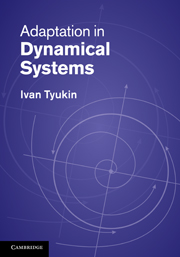Book contents
- Frontmatter
- Contents
- Preface
- Notational conventions
- Part I Introduction and preliminaries
- Part II Theory
- 4 Input–output analysis of uncertain dynamical systems
- 5 Algorithms of adaptive regulation and adaptation in dynamical systems in the presence of nonlinear parametrization and/or possibly unstable target dynamics
- Part III Applications
- Appendix. The Meyer–Kalman–Yakubovich lemma
- References
- Index
4 - Input–output analysis of uncertain dynamical systems
from Part II - Theory
Published online by Cambridge University Press: 03 May 2011
- Frontmatter
- Contents
- Preface
- Notational conventions
- Part I Introduction and preliminaries
- Part II Theory
- 4 Input–output analysis of uncertain dynamical systems
- 5 Algorithms of adaptive regulation and adaptation in dynamical systems in the presence of nonlinear parametrization and/or possibly unstable target dynamics
- Part III Applications
- Appendix. The Meyer–Kalman–Yakubovich lemma
- References
- Index
Summary
In this chapter we provide analysis tools for dynamical systems described as input–output and input–state mappings (or simply operators) in the corresponding spaces. Such a description is advantageous and natural when mathematical models of the systems are vaguely known and uncertain. We will see that the basic properties of these input–output and input–state mappings (such as boundedness and continuity) constitute important information for our understanding of the various ways in which an adaptation can be organized in these systems.
In particular, we will see that some basic stability notions (Lyapunov stability of invariant sets (LaSalle and Lefschetz 1961), stability of solutions in the sense of Lyapunov, and input-to-state, input-to-output, output-to-state, and input–output stability (Zames 1966)) are equivalent to continuity of a certain mapping characterizing the dynamics of the system (Theorems 4.1 and 4.3).
As we have said earlier, real physical systems, however, are not always stable and hence their input–output and input–state characterizations are not always continuous. Moreover, the target dynamics of these systems should not necessarily admit continuous input–output or input–state description. Indeed, continuity of a mapping S at a given point u0 in essence reflects the fact that the value of the mapping S(u), can be made arbitrarily close to S(u0), provided that u remains sufficiently close to u0. In reality this is a quite idealistic picture, and in most cases such infinitesimal closeness is not needed.
- Type
- Chapter
- Information
- Adaptation in Dynamical Systems , pp. 83 - 150Publisher: Cambridge University PressPrint publication year: 2011



